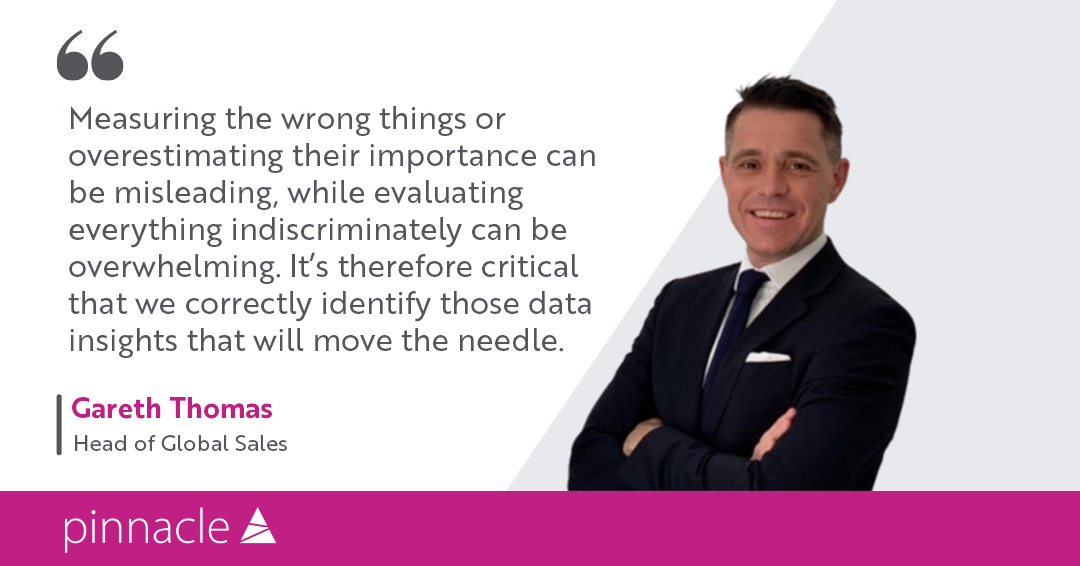
“Half my advertising spend is wasted; the trouble is, I don’t know which half.” Depending on which side of the Atlantic you’re on, this famous quote is regularly attributed to either U.S. retail magnate and forefather of marketing John Wanamaker or to UK industrialist Lord Leverhulme (of Lever Brothers fame).
It’s often trotted out in seminars about marketing effectiveness and while some might argue that the same still holds true today, we know that it really shouldn’t. Because, let’s face it, there’s nothing that we do in this world, particularly the business world, that doesn’t get measured. Every digital engagement, every step we take, every purchase we make, every decision and every outcome, it’s all monitored, measured, popped into a data cube where it’s sliced and diced, and then served up in eye-catching dashboards or fed into an algorithm.
Law firms are not exempt. Indeed, they might drive through matters, but they are driven by data. Over the past three decades first reporting and latterly BI tools have grown in sophistication, mining and synthesising huge data stores to help evaluate past performance to inform future planning.
As legal practices have gradually morphed into legal businesses, professionalising the strategic, operational and fiscal management of the organisation alongside its legal service delivery, so the spotlight has fallen on departments like marketing and business development to measure themselves with the same rigour as the practice groups.
They need to know which 10, 20 or 50% of their output isn’t working and to take remedial action accordingly; or which 30% is working and to dial up more of it. Ultimately, they need to demonstrate their value to the partnership by mirroring their acuity around business intelligence: not just in terms of understanding what it’s telling you but formulating actionable plans off the back of it.
One of the biggest challenges for marketing/BD teams though is identifying the metrics that actually matter. Fee earners and finance run with a well-worn playbook but law firm marketing, as a maturing discipline, not so much. Mainstream marketing analytics theory is great but what comes out of those FMCG brands that have data from millions of customers is unlikely to apply the same way to a law firm that might only be measuring the engagement of 100 people.
Measuring the wrong things or overestimating their importance can be misleading, while evaluating everything indiscriminately can be simply overwhelming. There’s a high risk of ‘paralysis by analysis’ or being misdirected by misinterpreted data. It’s therefore critical that we correctly identify those data insights that will move the needle.
Take pitching for new work as a good example. How do you even apply science to the art of pitching? By applying a clever analytics layer that can extract every last ounce of meaning from a pitch or proposal – the content, the numbers, win/loss result, client sector etc, and present it back to your Marketing & BD decision makers as meaningful intelligence.
Take these examples drawn from the analytics capability within Pinnacle’s PitchPerfect proposal automation tool. CMOs are routinely measuring:
Diversity
Diversity and inclusion credentials are becoming a common ask on RFPs and law firms are giving more and more thought to this in team selection. PitchPerfect allows a CMO to create reports that can answer very specific queries such as: “What is the gender diversity in winning pitches for banking deals over the value of $500K in New York?”
Content performance
In much the same way analytics tools inform you about web page performance, CMOs can see how often each individual content piece is used, how often it features in winning pitches, its comparative performance in different industry sectors or territories and so on. It’s all qualitative feedback that lets them fine-tune their language to resonate better next time and ensure the benefits they are pitching are suitable to that prospective client in that sector or industry.
Optimal composition
What does a winning pitch look like? Length, order, components, styling, all these factors can be examined and further analysed from a sectoral or territorial perspective to give you a better chance of coming up with the best combination every time.
Content updates
Pitching draws on a deep, broad well of content and it’s easy to forget when something hasn’t been updated for two years. The simple expedient of being able to flag stale content and swap it in for some fresh, killer material could be the difference between winning and losing. And knowing who in your team is keeping on top of that task just strengthens your hand when it comes to marketing team management.
These are just a handful of examples that are regularly cited by the CMOs that we are talking to every day. But as the PitchPerfect analytics tool is built on Power BI, it’s fully configurable so can flex to be as expansive or as nuanced as you need it to be, depending on your firm profile, strategy, clients, or work types.
If you want to do BD smarter contact us for a demo on pitchperfect@pinnacle-oa.com
